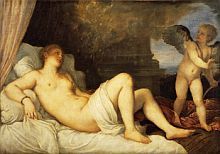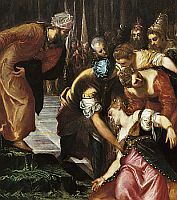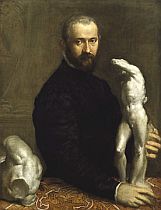 |


Feature Archive
Venetian Rivals
|
Titian, Tintoretto, Veronese...

Recently at the Museum of Fine Arts, Boston

Currently on view at the Musée du Louvre, Paris through January 4, 2010
|
| By Joseph Phelan |
|
|

Titian: DanaŽ
(Click "learn more" to access an enormous scan of this painting)
Titian (c.1488-1576) was the supreme figure in Venetian art from 1515 on. His extremely long life meant that the younger painters Tintoretto (1518-1594) and Veronese (1528-1588) overlapped creatively and professionally with him for nearly 40 years.
By significantly grouping two or three canvases, curator Frederick Ilchman has lovingly re-created, through carefully chosen juxtapositions, the heated atmosphere of artistic creation in the 16th-century republic, showing how these younger men forged their own distinct painterly styles by responding to Titian and each other, and demonstrating in the process how competition inspires the achievements of even the greatest artists.
At the start of the show we see two religious pictures, one by the young Titian and the other by his teacher Bellini. These are examples of a popular Venetian genre, known as a Sacra Conversazione, a "sacred conversation" among the Virgin, Child, and assorted saints. Bellini's panel (see Metropolitan Museum of Art collection) has a ravishingly beautiful palette, but the holy protagonists gaze left or out at us rather than at each other and seem frozen, aloof, disconnected.
Titian, by contrast, invites us into a silent narrative (see reproduction from a previous exhibition). On the right, St. Dominic and the donor seem to have just arrived, drawing the gazes of the Virgin and Child toward the fervent supplicants. We see Titian building on the broad and firm foundation of his teacher while developing a highly original way of conceiving and dramatizing his subject. We are especially taken by the handsome, idealized Saint Dominic, and the sensitive face of the donor qualifies as an early Titian portrait of distinction.
For it was in the field of portraiture that Titian marked out his claim to fame. With his magical ability to paint men and women of high rank not as they were but as they wished to be, Titian endowed his sitters with the nobility, power, and dignity that a ruler must have but that may have eluded many of them in real life. He thereby established the conventions of aristocratic and kingly portraiture.
A prime example of Titian's portraiture is the closeup of the 74-year-old Paul III (see mini-site, thumbnail 2), the last of the Renaissance popes, the reluctant reformer of the church, and the patron of Michelangelo's Last Judgment. Sitting on his throne, he seems to have just turned to look at us from atop a mountain of crushed velvet, his dark, arresting eyes full of reason and the will to power.
After confronting Titian's portrayal, one cannot conceive a more monumental, direct, or forceful image of this paragon of spiritual and worldly power. With this work, the artist won international fame the sort of which had never before been conferred on an artist. Other great portrait painters such as El Greco and Velázquez learned a great deal from him, but it is arguable if any later painter ever surpassed this portrait.
Titian's mid-career success around 1645 with the international elite opened up opportunities in Venice for younger men. First among these was Tintoretto, whose smoldering self-portrait (see mini-site, thumbnail 4) announces his arrival as an ambitious, confident risk-taker. While Titian brooded over his compositions for months and even years, Tintoretto marketed himself as a kind of anti-Titian, painting large canvases at great speed while cutting prices and even giving his work away to the various Venetian confraternities that were so much a part of the Serene Republic's social network.
One of the important patrons he sought out was the brilliant satirist, writer, and publicist Aretino, offering this close friend of Titian a painting for his ceiling with the self-referential Flaying of Marsyas, a learned and cheeky calling card that announced his challenge to the older master.
As a way of further differentiating himself, Tintoretto began a long study of Florentine design, going so far as to display in his studio the motto "the draftsmanship of Michelangelo, the coloring of Titian." Tintoretto's Baptism of Christ (see Prado Museum collection), with the towering, muscular bodies of Christ and the Baptist, is a brilliant example of this synthesis.
The arrival of Veronese 10 years later further turned up the thermostat of the already hothouse atmosphere of the Venice art scene. The younger man modeled himself on Titian, while the wily Titian used Veronese to undercut the hated Tintoretto. From his youth, Veronese made his name as an opulent colorist and he was to grow into the master of enormous feast scenes painted on canvas for the walls of refectories.
If visitors still need an added incentive to attend a show filled with the constant parleys of painterly rivalry, they should be more than satisfied with the mythological nudes. Venice in this period was famous for its courtesans and prostitutes who numbered in the thousands, making it the "brothel of Europe." It is no surprise that highly sophisticated depictions of female sensuality were first developed there. While it was a Florentine painter, Botticelli, who first monumentalized the Renaissance female nude in the 15th century with his Birth of Venus, it was Titian and his short-lived colleague Giorgione who reimagined her as reclining, voluptuous, and earthly.
With his Danae (see mini-site), Titian's magic ability to turn paint into living flesh is astonishing. The artist breathes new life into the ancient myth of the young princess and beloved of Zeus who is shut up in a high tower by her fearful father. We apprehend the umber, soft gold, deep red, and cream tones of painting as an invitation to sexual desire, yet still are attracted to the individuality of the woman anticipating her lover's arrival in the form of soft golden rain. Even his archrival Michelangelo had praise for this work's life-giving vitality when he saw it in Rome.
Responding to Titian, Tintoretto produced his Susannah and the Elders (see mini-site, thumbnail 2). The biblical story of the virtuous wife slandered by two prurient old men offered the artist an opportunity to create his own luminous female nude in a paradisal setting. We notice the bald heads of the men hidden away in the left hand corner only with some effort, but once we do, we appreciate the dramatic bite of this calm-before-the-storm composition even more.
The show ends with homage to the late painting styles of our trio. Titian once again sets the highest possible standard for his younger rivals. In his Tarquin and Lucretia (see mini-site), the aged master returns to his great theme of eros to show its darkest dimensions. In what is undoubtedly the most brutal rape scene in all large-scale paintings of the Renaissance, he demonstrates how this medium can rise to the heights of tragic utterance previously reserved for dramatic poetry.
Tintoretto offers an even more shocking composition (see mini-site, thumbnail 2), with the already-nude Tarquin ripping the necklace off his victim's neck. As Lucretia's pearls fall onto the floor they become a metaphor for her impending loss of virtue, just as her tears will be transmuted into jewels of honor.
Tintoretto outlasted both his rivals by a decade and has the last word in this show. His Florentine contemporary, the painter and historian Giorgio Vasari, called him the most extraordinary brain in the history of painting. His aged self-portrait (see mini-site, thumbnail 3) is an uncompromising picture of an exhausted old man whose mind continues to rage.
The rivalry of the Venetian golden age constitutes one of the richest chapters in the history of art. Together, Titian, Tintoretto, and Veronese created an unparalleled body of work, opened up new avenues of aesthetic expression, and forged a golden chain of influence that runs from El Greco, Rembrandt, and Velázquez to Willem de Kooning and Lucian Freud.
Artists mentioned in the article:
Titian
Tintoretto
Paolo Veronese
Giovanni Bellini
Michelangelo
Botticelli
Giorgione
Giorgio Vasari
El Greco
Rembrandt
Diego Velázquez
Willem de Kooning
Lucian Freud
External links:
Louvre Museum mini-site for Titian, Tintoretto, Veronese...
|
|
Past Articles
2009
Fritz Scholder: Indian/Not Indian, by K. Kimberly King
2008
"The Primacy of Color", by K. Kimberly King
Fame and the Founding Father, by Joseph Phelan
"There is no final photograph", by K. Kimberly King
2007
How Edward Hopper Saw the Light, by Joseph Phelan
Giving "New Worlds to the World": Portugal and the World in the 16th and 17th Centuries, by K. Kimberly King
London Views: Spring 2007 and Beyond, by Diane Apostolos-Cappadona
Modernism: Designing a New World, 1914-1939, by K. Kimberly King
Italian Women Artists from Renaissance to Baroque, by Diane Apostolos-Cappadona
What Jasper Johns "Can't Avoid Saying", by K. Kimberly King
Holy Image/Hallowed Ground: Icons from Sinai, by Diane Apostolos-Cappadona
2006
Prayers and Portraits: Unfolding the Netherlandish Diptych, by Diane Apostolos-Cappadona
Stop, See, and Soar:
"Société Anonyme", by K. Kimberly King
Constable's Great Landscapes, by Joseph Phelan
Editorial: Save Studio 60 (from needing to be saved), by John Malyon
Far From Heaven: Anselm Kiefer at the Hirshorn, by Joseph Phelan
Henri Rousseau: Self-Taught in Paris, by K. Kimberly King
Klee, Hitler and America, by Joseph Phelan
Anyone For Venice?, by Joseph Phelan
The Legends of Leonardo, by Joseph Phelan
Hey, "Dada"-Dude, Where's the Rest of Me?, by K. Kimberly King
Cézanne in Provence, by Joseph Phelan
Angels in America: Fra Angelico in New York, by Joseph Phelan
2005
Notes on New York (NoNY), by Joseph Phelan
The Greatest Painting in Britain
French Drawings and Their Passionate Collectors, by Joseph Phelan
Missing the Picture: Desperate Housewives Do Art History, by Joseph Phelan
The Salvador Dalí Show, by Joseph Phelan
2004
Boston Marathon, by Joseph Phelan
Philadelphia is for Art Lovers, by Joseph Phelan
Featured on the Web: Understanding Islamic Art and its Influence, by Joseph Phelan
Independence Day: Sanford R. Gifford and the Hudson River School, by Joseph Phelan
The "Look" of Mel Gibson's The Passion of the Christ, by Joseph Phelan
The Importance of Being Odd: Nerdrum's Challenge to Modernism, by Paul A. Cantor
2003
Advent Calendar 2003, narrated by Joseph Phelan
If Paintings Could Talk: Paul Johnson's Art: A New History, by Joseph Phelan
Mad Max [Max Beckmann], by Joseph Phelan
Marsden Hartley: The Return of the Native, by Joseph Phelan
Jean-Antoine Houdon: Sculptor of the Enlightenment, by Joseph Phelan
Frederic Remington's Nocturnes, by Joseph Phelan
Magnificenza! Titian and Michelangelo, Manet and Velazquez, by Joseph Phelan
Masterful Leonardo and Graphic Dürer, by Joseph Phelan
Favorite Online Art Museum Features, by Joseph Phelan
Studies for Masterpieces, by John Malyon
2002
Portrait of the Artist as a Serial Killer, by Joseph Phelan
Renoir's Travelling, Bonnard's "At Home, by Joseph Phelan
The Philosopher as Hero: Raphael's The School of Athens, by Joseph Phelan
The Greatest Works of Art of Western Civilization
Celebrating Heroes; Celebrating Benjamin West, by Joseph Phelan
Chasing the Red Deer into the American Sublime (Education and the Art Museum, Part II), by Joseph Phelan
Planning Your Summer Vacation, by Joseph Phelan
Education and the Art Museum, Part I, by Joseph Phelan
Unsung Griots of American Painting, by Joseph Phelan
The British Museum COMPASS Project, interview by Joseph Phelan
Robert Hughes, Time Magazine Art Critic: Biography and Writings
2001
Software review: Le Louvre: The Virtual Visit on DVD-ROM, by Joseph Phelan
Tragedy and Triumph at Arles: Van Gogh and Gauguin, by Joseph Phelan
Her Last Bow: Sister Wendy in America, by Joseph Phelan
Love, Death and Resurrection: The Paintings of Stanley Spencer, by Joseph Phelan
Who is Rodin's Thinker?, by Joseph Phelan
Celebrations North and South, by Joseph Phelan
Rubens and his Age, by Joseph Phelan
Great Reproductions of Great Paintings
The Passion of Christ, by Joseph Phelan
Edouard Manet: Public Spaces, Private Dreams, by Joseph Phelan
Henry Moore and the British Museum: The Great Conversation, by Joseph Phelan
2000
Notorious Portraits, Part II, by John Malyon
Notorious Portraits, Part I, by John Malyon
The Other Michelangelo, by Joseph Phelan
The Art of Drawing, by Joseph Phelan
Poussin and the Heroic Landscape, by Joseph Phelan
Great Art Museums Online, by Joseph Phelan
Venetian Painting and the Rise of Landscape, by Joseph Phelan
Forbidden Visions: Mythology in Art, by Joseph Phelan
Themes in Art: The Passion of Christ, by Joseph Phelan
Web site review: Christus Rex
Web site review: National Gallery of Art, Washington, D.C., by Joseph Phelan
Online exhibit review: Inuit Art: The World Around Me, by John Malyon
Poll: Who is Producing the Most Interesting Art Today? (Results)
Poll: Who is Producing the Most Interesting Art Today? (Part II)
1999
Poll: Who is Producing the Most Interesting Art Today? (Part I)
Spotlight on The Louvre Museum
Spotlight on Impressionism
Spotlight on Optical Art
Spotlight on Animals in Art
Spotlight on Surrealism
Spotlight on Sculpture
Spotlight on Women in the Arts
Spotlight on The Golden Age of Illustration
Spotlight on Vincent van Gogh
Spotlight on Great Art
|


